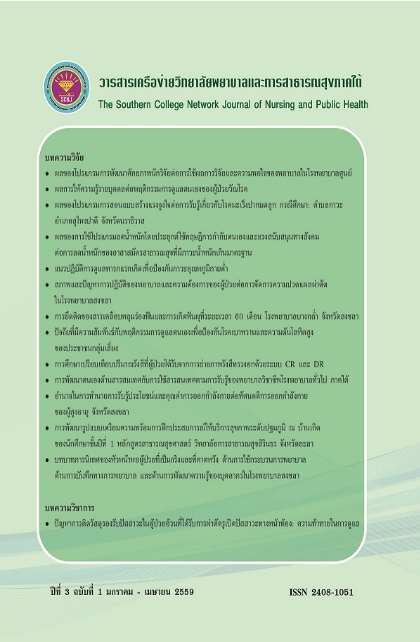อำนาจในการทำนายการรับรู้ประโยชน์และคุณค่าการออกกำลังกายต่อ ทัศนคติการออกกำลังกายของผู้สูงอายุ จังหวัดสงขลา
คำสำคัญ:
การรับรู้ประโยชน์และคุณค่า, ทัศนคติการออกกำลังกาย, ผู้สูงอายุ, Perceived Benefits, Exercise, Attitude, Older Adultsบทคัดย่อ
การวิจัยเชิงพรรณนานี้มีวัตถุประสงค์ เพื่อศึกษาระดับการรับรู้ประโยชน์และคุณค่าการออกกำลังกาย ระดับทัศนคติการออกกำลังกายของผู้สูงอายุ และอำนาจในการทำนายการรับรู้ประโยชน์และคุณค่าการออกกำลังกายต่อทัศนคติการออกกำลังกายของผู้สูงอายุ จังหวัดสงขลา กลุ่มตัวอย่างคือผู้สูงอายุจากชมรมผู้สูงอายุในจังหวัดสงขลา จำนวน 138 คน คำนวณกลุ่มตัวอย่างโดยใช้โปรแกรม G*Power สุ่มตัวอย่างแบบง่ายโดยหยิบฉลากแบบไม่คืนที่ เครื่องมือที่ใช้คือแบบสอบถามผ่านการหาความตรงเนื้อหาจากผู้เชี่ยวชาญ และหาความเที่ยงตรงเชิงเนื้อหาโดยใช้สูตรสัมประสิทธิ์แอลฟาของครอนบาค ได้ค่าความเชื่อมั่นเท่ากับ .89 วิเคราะห์ข้อมูลโดยใช้สถิติเชิงพรรณนา สถิติสัมประสิทธิ์สหสัมพันธ์เพียร์สัน และสถิติถดถอยอย่างง่ายด้วยวิธี All Enter ผลการศึกษาพบว่า
1. การรับรู้ประโยชน์และคุณค่าของการออกกำลังกายในภาพรวมของผู้สูงอายุจังหวัดสงขลาอยู่ในระดับดี (M=4.30, SD=0.88) โดยด้านการรับรู้คุณค่าของการออกกำลังกายมีค่าเฉลี่ยสูงสุด (M=4.39, SD=0.86) รองลงมาคือการรับรู้ประโยชน์ของการออกกำลังกายที่มีต่อร่างกาย และการรับรู้ประโยชน์ของการออกกำลังกายที่มีต่อจิตใจ (M=4.34, SD=0.87 และ M=4.16, SD=0.92 ตามลำดับ)
2. ระดับทัศนคติการออกกำลังกายของผู้สูงอายุจังหวัดสงขลาในภาพรวมอยู่ในระดับปานกลาง (M=3.63, SD=1.02) โดยมีความพร้อมในการออกกำลังกาย และการรับรู้หลักและวิธีการออกกำลังกายอยู่ในระดับดี (M=4.12, SD=0.94 และ M=4.08, SD=0.96 ตามลำดับ) และความรู้สึกต่อการออกกำลังกายอยู่ในระดับปานกลาง (M=2.69, SD=1.14)
3. การรับรู้ประโยชน์และคุณค่าการออกกำลังกายมีความสัมพันธ์ทางบวกในระดับปานกลางกับทัศนคติการออกกำลังกายของผู้สูงอายุ จังหวัดสงขลา (r=.505) และสามารถทำนายได้ร้อยละ 25.50 อย่างมีนัยสำคัญทางสถิติที่ระดับ .001
ผลการศึกษานี้ มีข้อเสนอแนะให้บุคลากรด้านสาธารณสุข ผู้บริหารองค์กรปกครองส่วนท้องถิ่นและบุคลากรด้านวิทยาศาสตร์การกีฬาที่เกี่ยวข้อง ควรมีการส่งเสริม สนับสนุนให้ผู้สูงอายุมีความรู้ ความเข้าใจและมีทัศนคติที่ดีต่อการออกกำลังกายตามหลักวิทยาศาสตร์การกีฬา ตลอดจนช่วยส่งเสริมให้ ผู้สูงอายุมีการออกกำลังกายเป็นประจำ
Perceived Benefits and Attitude Towards Exercise among Older Adults in Songkhla: Prediction Factors
This descriptive research aimed to: 1) study the perceived benefits and attitude towards exercise, and 2) consider factors for prediction of perceived benefits and attitude towards exercise among older adults. Sample was 138 adults aged 60 years or older who attended the elderly clubs in Songkhla Province. The sample size was calculated using G* Power program. Simple random sampling without replacement was used. Research instrument was a questionnaire consisting in five parts: 1) demographic data, 2) perceived benefits of exercise, 3) knowledge about exercise, 4) perceived value of exercise, and 5) perceived self-efficacy. Its content validity was confirmed by three experts. The Cronbach’s alpha coefficient was used to examine reliability of the questionnaire, yielding a value of .89. The data were analyzed using descriptive statistics, Pearson’s Product Moment correlation, and Simple Regression analysis with All Enter method.
The results of the study found the following.
1. Overall, the perceived benefits and value of exercise was at a good level (M=4.30, SD=0.88). The top three of mean scores were the perceived value of exercise (M=4.39, SD=0.86), the perceived benefit of exercise to their body (M=4.34, SD=0.87), and the perceived benefit of exercise to their mind (M=4.16, SD=1.14), respectively.
2. Overall, level of attitude towards exercise was at a moderate level (M=3.63, SD=1.02). When considering in each part, readiness for exercise and perception of principles and methods of exercise were at a good level (M=4.12, SD=0.94, and M=4.08, SD=0.96, respectively). And attitude towards exercise was at a moderate level (M=2.69, SD=1.14).
3. Perceived benefits of exercise was statistically significant when correlated with attitude towards exercise (r=0.505, p<.01). And a simple regression analysis found that perceived benefits and value of exercise were accounted for 25.50% of the variance in attitude scores.
The findings of this study suggest that involving health personnel, administrators of local administrative organization, and personnel of sport science should promote the older adults in term of knowledge and understanding about exercise, and positive attitude towards exercise following principle of sport science. And they should empower the older adults to exercise regularly
ดาวน์โหลด
เผยแพร่แล้ว
ฉบับ
ประเภทบทความ
สัญญาอนุญาต
1. บทความหรือข้อคิดเห็นใด ๆ ที่ปรากฏในวารสารเครือข่าย วิทยาลัยพยาบาลและการสาธารณสุขภาคใต้ ที่เป็นวรรณกรรมของผู้เขียน บรรณาธิการหรือเครือข่ายวิทยาลัยพยาบาลและวิทยาลัยการสาธารณสุขภาคใต้ ไม่จำเป็นต้องเห็นด้วย
2. บทความที่ได้รับการตีพิมพ์ถือเป็นลิขสิทธิ์ของ วารสารเครือข่ายวิทยาลัยพยาบาลและการสาธารณสุขภาคใต้








